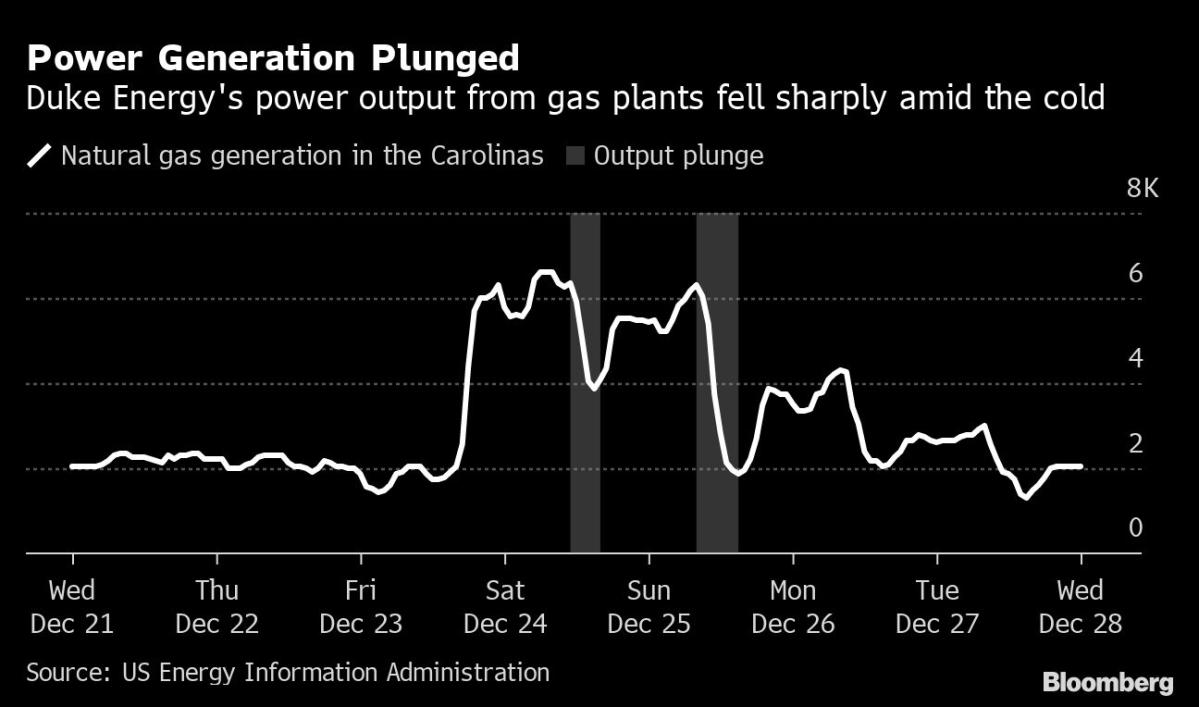
(Bloomberg) — The states hit hardest by blackouts in last week’s winter storm have significantly increased reliance on heating homes with electricity over the last decade, putting more strain on the power grid when temperatures plummet.
The number of households using electric heat in Tennessee, North Carolina and South Carolina increased by about 20% from 2009 to 2020, according to government data that survey a sample of households. The generating capacity of power plants in the region, meanwhile, has remained relativity flat and increasingly dependent on natural gas.
Those trends played out in dramatic fashion on Dec. 23 and Dec. 24 when temperatures in the region plunged to around 10F (-12C), millions of people cranked up their heat and flows of natural gas plummeted along the East Coast as equipment froze. Utilities were forced to institute rolling blackouts as power plants failed and demand overwhelmed the system.
The outages exposed a challenge grid operators likely will confront more often during cold blasts as utilities move to clean up their power supplies to combat climate change while an increasing number of homes and businesses turn to electricity instead of gas, oil or propane to supply heat.
“We have moved too swiftly over the past two decades to electrify residential heating,” said Pat Wood, chief executive officer of Hunt Energy Network and former chairman of the Federal Energy Regulatory Commission. “When that is combined with poorly insulated housing and low-efficiency appliances, we tax all of our resources across the board.”
In Tennessee, the number of households using electric heat has increased by about 22% from 2009 to 2020, driven in part by population growth, according to government data. Over that same time period, the percent of households dependent on electric heating jumped to 69% from 63%, the data show.
That rise in electric heating demand came as Tennessee’s total power generation remained largely unchanged. Meanwhile, its fuel mix became far more dependent on cleaner burning natural gas than coal, government data show.
Tennessee Valley Authority, a federal agency that supplies power in the region, was forced for the first time to institute rotating outages on Dec. 23 and Dec. 24 as demand soared to a winter record.
“We are conducting a thorough review of what occurred and why,” TVA said in a statement Wednesday. “We are committed to sharing these lessons learned and – more importantly – the corrective actions we take in the weeks ahead to ensure we are prepared to manage significant events in the future.”
The push to electrify household appliances and heating has changed consumption patterns and created regions where electricity demand now peaks in both summer and winter, according to Sanjeet Sanghera, head of grids and utilities at BloombergNEF. That’s a shift from the past when electricity demand peaked in the summer due to air conditioner use but not in the winter as homes burned natural gas or oil for heat.
“This shift is significant as it has many important implications for grid operations,” Sanghera said in an email. “If you forecast the peak incorrectly, you could end up with limited options to balance the grid and need to turn to rotating outages.”
In North and South Carolina, which were also hit by blackouts as energy use overwhelmed the grid, the number of homes using electric heat rose about 20% from 2009 to 2020, the data show. The total overall percent of households in those states relying on electric heat also climbed from 65% in 2009 to 70% in 2020.
Over that same time period, the total power supplies for the two states grew at just 2%, with coal being displaced mostly by natural gas units and some solar farms, the data show.
For Duke Energy in North Carolina, a greater dependence on gas appears to have caused problems during the winter storm. Power generation from natural gas plants started falling on Dec. 24 and plunged by more than 4.4 gigawatts, or 70%, from 8 a.m. to 3 p.m. on Dec. 25, government data show. During that time, gas supplied only 15% of the power in Duke’s Carolinas utility territory, roughly half of what it was supplying before the plunge.
Duke was forced to cut power to customers on Dec. 24 as demand overwhelmed supply. It’s neighboring utility Santee Cooper had to do the same in South Carolina.
Representatives for Duke and Santee Cooper didn’t immediately respond to emails seeking comment.
©2022 Bloomberg L.P.